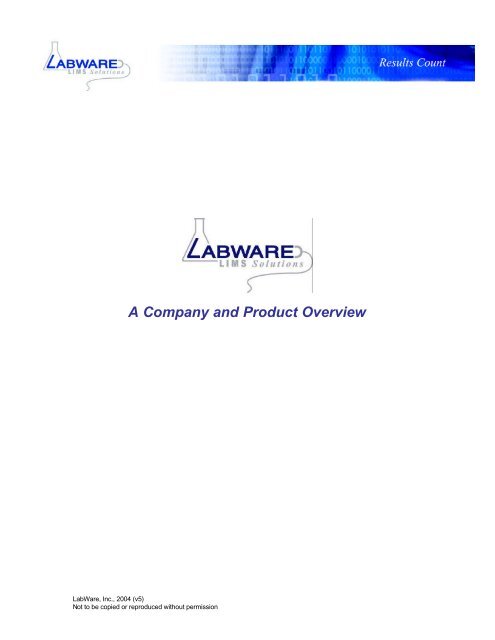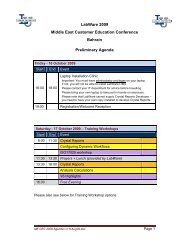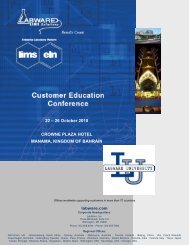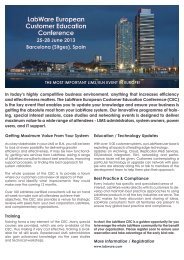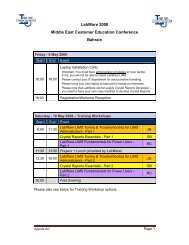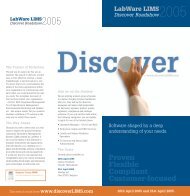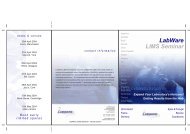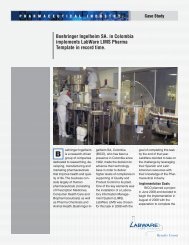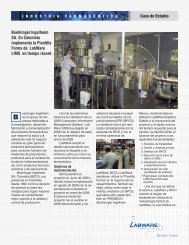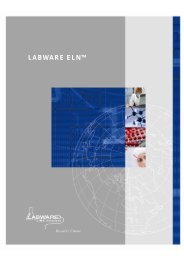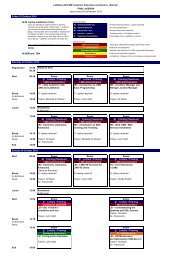Download - LabWare
Download - LabWare
Download - LabWare
Create successful ePaper yourself
Turn your PDF publications into a flip-book with our unique Google optimized e-Paper software.
A Company and Product Overview<br />
<strong>LabWare</strong>, Inc., 2004 (v5)<br />
Not to be copied or reproduced without permission
Company Background<br />
<strong>LabWare</strong>, Inc. is a privately owned company with its worldwide headquarters in<br />
Wilmington, Delaware. The company specializes in the design, supply and<br />
support of enterprise-scale LIMS solutions. Since its registration in 1988,<br />
<strong>LabWare</strong> has continued to grow with no external funding or net borrowings. We<br />
are an exciting and innovative company whose robust growth is being achieved<br />
in a manageable fashion.<br />
Laboratory automation is the core business of <strong>LabWare</strong>, and our primary focus is<br />
Laboratory Information Management Systems (LIMS). Our flagship product is<br />
<strong>LabWare</strong> LIMS, which includes an integrated instrument-interfacing module<br />
called LabStation. <strong>LabWare</strong> is not owned by any outside parent company or<br />
investor group, nor is LIMS a small sideline business for us. Furthermore,<br />
<strong>LabWare</strong> is not distracted by having to support multiple LIMS products. A<br />
company can only have one “top” priority. In <strong>LabWare</strong>’s case that priority is very<br />
clear; <strong>LabWare</strong> is focused exclusively on LIMS, and directs all of its effort toward<br />
a single functionally diverse product – <strong>LabWare</strong> LIMS v5.<br />
<strong>LabWare</strong> is recognized worldwide as a marketplace leader. LIMS Administrators<br />
and end-users consistently rate <strong>LabWare</strong>, Inc. at the top of the industry in<br />
customer satisfaction, and as the company with the best and most innovative<br />
technology. <strong>LabWare</strong> LIMS v5 is differentiated by its rich functionality and by its<br />
configuration-driven approach to meeting customers’ business requirements<br />
without resorting to customization. Our company is founded on the philosophy of<br />
offering the most comprehensive LIMS features out of the box, and enabling<br />
these features to be tailored by the customer using configuration dialogs and<br />
editors, thus avoiding a reliance on customization and code development.<br />
<strong>LabWare</strong> believes that customization is fundamentally the wrong approach<br />
because it places the customer at significant risks. The short-term risk is in<br />
having its implementation delivered late and over budget due to the enormous<br />
design and testing burden, as well as the technology learning curve the project<br />
team must endure just to be productive. The long-term risks are in the difficulty<br />
of upgrading, the complexity of technical support and, for regulated companies,<br />
the difficulty of validation.<br />
With <strong>LabWare</strong> LIMS, all of the configuration settings that define the way your<br />
systems will function are stored in the LIMS database and are completely audit-<br />
trailed by the application. Configuration does not change the base product or the<br />
source code in any way. With alternative LIMS products, business requirements<br />
can only be met by altering the product source code, or by creating programmatic<br />
extensions to the system that have source code dependencies. In many cases,<br />
these changes and additions are NOT stored in the database, nor are they<br />
automatically audited. They are stored in text files that must be compiled before<br />
they can be used, and even in cases where they are created as stored<br />
<strong>LabWare</strong>, Inc., 8/2004 (v6) 2<br />
Not to be copied or reproduced without permission
procedures, they are not controlled or audited in any way within the application<br />
and must be managed. The <strong>LabWare</strong> approach greatly reduces risk, complexity<br />
and testing [validation] effort. In the long-term, <strong>LabWare</strong> customers are able to<br />
stay current with our technology because the product supports an automated<br />
upgrade process that can migrate all configuration settings to the new version.<br />
About the <strong>LabWare</strong> LIMS Architecture<br />
<strong>LabWare</strong> LIMS is an object-oriented Client/Server application designed<br />
specifically for the Microsoft Windows graphical user interface. From its original<br />
inception the product has evolved in its current development environment and<br />
with its current architecture, and there has never been a major product transition<br />
necessitated by technology (for example, the migration of pre-Windows legacy<br />
code). It is developed entirely in the industry’s most functionally robust objectoriented<br />
programming language, for which a full ANSI standard specification has<br />
been available for over 20 years. Therefore it is not associated with or reliant<br />
upon any commercial vendor for its support, making its long-term viability<br />
assured and providing an unprecedented degree of stability and investment<br />
protection for our customers.<br />
<strong>LabWare</strong> LIMS conforms to all applicable industry standards and protocols.<br />
<strong>LabWare</strong> LIMS uses standard ODBC 3.0 drivers for database communication,<br />
and operates over TCP/IP. Citrix technology is fully supported and is one of the<br />
most proven technologies for deploying <strong>LabWare</strong> LIMS across a wide geographic<br />
area. <strong>LabWare</strong> LIMS also includes full support for XML-based data exchange.<br />
All LIMS records can be imported and exported using XML format. XML viewers<br />
have been built into <strong>LabWare</strong> LIMS 5.0 that can parse XML documents and view<br />
information from XML data structures.<br />
<strong>LabWare</strong> LIMS offers a Web-based interface using a J2EE compliant application<br />
server. The J2EE server and LIMS application server communicate using XML<br />
messages compatible with the Industry Standard SOAP protocol over TCP/IP.<br />
Numerous mechanisms are available in <strong>LabWare</strong> LIMS to interface with other<br />
systems and databases. The system has the ability to issue any SQL statements<br />
against another database system, and also includes a full-featured built-in<br />
scripting language called “LIMS Basic”, which enables the customer to implement<br />
fully supportable customer-configured extensions to the application’s<br />
functionality. <strong>LabWare</strong> LIMS provides for the creation of flexible subroutines and<br />
triggered events allowing a sequence of steps to be automated. These<br />
subroutines are often employed to facilitate communication with other external<br />
information systems. <strong>LabWare</strong> LIMS also includes a Database Management<br />
Utility that allows records to be imported to or exported from the LIMS database<br />
via CSV formatted ASCII text files.<br />
<strong>LabWare</strong>, Inc., 8/2004 (v6) 3<br />
Not to be copied or reproduced without permission
<strong>LabWare</strong> has collaborated to develop embedded LIMS functionality and features<br />
that enhance the level of integration with systems provided by strategic business<br />
partners such as Waters NuGenesis for its SDMS solutions as well as for the<br />
Millennium 32 and Empower Chromatography Data Systems, SAP for R3 and R4,<br />
Northwest Analytical for its Quality Analyst OCX technology, and Documentum<br />
for its GxPharma EDMS. <strong>LabWare</strong> makes these integration features available as<br />
modules, available at no additional license cost.<br />
Instrument interfacing is accomplished with our own integrated LabStation<br />
module, which is a built-in module of the <strong>LabWare</strong> LIMS application. This<br />
powerful software component makes it possible to interface with virtually any<br />
instrument or instrument data system, including RS-232 devices as well as<br />
software-controlled instruments such as chromatography data systems and other<br />
types of intelligent instruments.<br />
About <strong>LabWare</strong>’s Version Release Model<br />
Since the product’s initial release in 1994 there have been 5 major releases of<br />
<strong>LabWare</strong> LIMS, the most recent of which began shipping during February 2003.<br />
Customers are never forced to upgrade, and can continue receiving technical<br />
support from <strong>LabWare</strong> regardless of the release version that they are operating.<br />
<strong>LabWare</strong>’s product release model is closely linked to its quality system, which<br />
consists of standard operating procedures governing the entire development life<br />
cycle, and which includes online systems that control and document all software<br />
changes. <strong>LabWare</strong> LIMS is extensively tested prior to each software release<br />
utilizing formal test plans and scripts. A traceability matrix is used to cross<br />
reference functional requirements and capabilities to user documentation,<br />
functional specifications, and test plans. To add further assurance that the<br />
software performs as expected and documented, <strong>LabWare</strong> engages an external<br />
validation consultant to execute the test plans and to sign off on the software<br />
prior to release. All <strong>LabWare</strong> products are released only when the external<br />
validation company certifies that all test cases have tested successfully, and that<br />
everything essential to product release is complete and in order.<br />
The continual enhancements that <strong>LabWare</strong> makes to <strong>LabWare</strong> LIMS are<br />
provided to customers in the form of Modules that are released on an<br />
incremental basis. <strong>LabWare</strong> tries to release a new module every several<br />
months, based upon customer-driven input and enhancement requests. These<br />
modules can be added to an existing <strong>LabWare</strong> LIMS environment without<br />
requiring the customer to upgrade to a new version of the system. This<br />
minimizes the impact of adding new features to existing installations, and also<br />
aids in keeping our customers “current”. If a particular customer does not<br />
require or desire an available module, then they don’t have to load them.<br />
<strong>LabWare</strong>, Inc., 8/2004 (v6) 4<br />
Not to be copied or reproduced without permission
All of our product development follows the <strong>LabWare</strong> Quality System, which<br />
includes a System Development Life Cycle (SDLC). The name for the approach<br />
is the “Spiral Model”. Major elements and deliverables of this model include:<br />
• FRS – Functional Requirement Specification<br />
• SDD – System Design Documentation<br />
• User Manuals<br />
• Training Programs & Manuals<br />
• Test Plan & Scripts<br />
• Test Records<br />
• Traceability Matrix<br />
• Installation Guide<br />
<strong>LabWare</strong> has an SOP for coding standards, and they are followed during<br />
development. Code is audited and checked for compliance with the coding<br />
standards. SOP’s and on-line systems are used to control changes. Policies<br />
and procedures exist to control changes associated with the Quality System and<br />
Programs.<br />
All program changes are tracked using on-line systems called DevTrack and<br />
LabTrack. These systems are available for inspection during a vendor audit. All<br />
customers that have an active software maintenance plan have access to these<br />
on-line systems and may use them to download new modules, and all other code<br />
made available by <strong>LabWare</strong>. The <strong>LabWare</strong> LIMS application includes upgrade<br />
and migration utilities that fully automate the transition from one major revision<br />
level of the system to the next. The installation of individual enhancements (or<br />
Modules, as they are referred to in <strong>LabWare</strong> terminology) is a comparatively<br />
minor undertaking. The module, which is packaged into an SLL file and<br />
“published” by <strong>LabWare</strong> (i.e. made available to customers through our on-line<br />
support service) can be downloaded by the customer and stored in a directory on<br />
their LIMS system. The SLL is then bound to the LIMS application, and when<br />
<strong>LabWare</strong> LIMS next launches, the file will be processed by the application and its<br />
features will be expressed in the system.<br />
About Customer Involvement in the Product Enhancement Process<br />
<strong>LabWare</strong> responds positively to requests from customers to participate in prerelease<br />
field-testing, and from time to time, makes requests for volunteers from<br />
among the customer base, depending on the functionality of the individual<br />
module or the overall revision. In order to best understand this area, it is helpful<br />
to understand <strong>LabWare</strong>’s overall product enhancement model. <strong>LabWare</strong> solicits<br />
input regarding required new functionality from its customer base. If a customer<br />
submits and sponsors a request for a new feature, and if the decision is made to<br />
<strong>LabWare</strong>, Inc., 8/2004 (v6) 5<br />
Not to be copied or reproduced without permission
undertake the development of that feature, then <strong>LabWare</strong> normally engages that<br />
same sponsoring customer to assist in the design of the feature and also to act<br />
as “alpha” tester. “Beta” testing is more applicable to new release versions of the<br />
overall product. Commonly there are up to 10 customer beta testers. As one<br />
would expect, <strong>LabWare</strong> approaches this testing in a structured manner,<br />
recording all test activities and outcomes in our internal tracking database.<br />
A good example of how <strong>LabWare</strong> has worked very closely with a customer is a<br />
case involving one of the world’s largest manufacturers of heavy machinery and<br />
industrial engines. Collaboration began during 2002 with a specific focus on<br />
deployment of <strong>LabWare</strong> functionality via a web browser interface. The solution<br />
that resulted from this effort has lead to the evolution of <strong>LabWare</strong>’s current<br />
<strong>LabWare</strong> Web LIMS capability. This same customer also participated as the<br />
primary alpha tester of <strong>LabWare</strong>’s Interpretation Manager Module, and as a beta<br />
tester of the current <strong>LabWare</strong> LIMS v5 product. As a result of these activities,<br />
<strong>LabWare</strong> LIMS has been very rapidly deployed at multiple sites within this<br />
customer’s enterprise employing a combination of both served thin client and<br />
browser-based user interfaces, and at the same time has included enhanced<br />
features that were not previously available in the software.<br />
About Regulatory Compliance<br />
Because of the manner in which <strong>LabWare</strong> LIMS is configured rather than<br />
custom-coded, customers never waste valuable time re-implementing<br />
functionality when upgrading to a new version. This benefits all customers, but is<br />
of particular value to customers whose LIMS systems are subject to FDA<br />
regulation or oversight by other regulatory agencies. <strong>LabWare</strong> LIMS v5, as well<br />
as <strong>LabWare</strong>’s business processes, are designed to surpass compliance<br />
regulations and to exceed auditor’s expectations. <strong>LabWare</strong> LIMS was one of the<br />
very first applications to become 21 CFR Part 11 compliant when Version 4.0<br />
shipped in June 2000. Since that time, <strong>LabWare</strong> has been working with<br />
numerous customers in the pharmaceutical industry and experts on Part 11 to<br />
enable our product to meet the various company-specific interpretations of Part<br />
11. Our configurable approach to LIMS enables a customer to adjust the<br />
security settings and Part 11 specific business rules In <strong>LabWare</strong> LIMS in order to<br />
tailor the system to meet its regulatory requirements. We are the very first LIMS<br />
provider to embrace Public Key Infrastructure (PKI) technology and Digital<br />
Certificates & Signatures. This technology allows digitally signed Part 11<br />
electronic records to be reviewed and used outside of the LIMS environment that<br />
originally created them. We believe this technology represents the future for<br />
how Part 11 compliance will be achieved by multi-site laboratories that must<br />
inter-operate together in a synergistic fashion.<br />
<strong>LabWare</strong>, Inc., 8/2004 (v6) 6<br />
Not to be copied or reproduced without permission
<strong>LabWare</strong>’s company mission and vision for the future is to provide technology<br />
and solutions that will enable pharmaceutical laboratories to move towards a<br />
more paperless environment. To this end, <strong>LabWare</strong> has developed a novel<br />
solution that allows laboratories to replace their paper-based Analysis<br />
Worksheets with an all-electronic equivalent. The Electronic Worksheets feature<br />
of <strong>LabWare</strong> LIMS brings together all of the supporting analytical data for a series<br />
of similar samples or tests, such as sample preparation data, standards &<br />
reagents, and processed chromatograms or instrument reports placing them<br />
together in a single secure PDF document. Because LIMS assigns each<br />
Electronic Worksheet a unique identification number, they can be instantly<br />
recalled and displayed. During the review cycle, appropriate individuals within<br />
the organization can digitally sign the Worksheet. Working with our strategic<br />
software partners, such as Waters NuGenesis (CDS and SDMS), Documentum<br />
(EDMS), and SAP (MRP) we have built interfaces to allow analytical workflows to<br />
occur between these systems without the need to generate extra disk files. For<br />
example, the Waters Millennium 32 and Empower Chromatography Data System<br />
can be seamlessly operated directly from within LIMS, and data can be shared<br />
between <strong>LabWare</strong> LIMS and these systems in a programmatic and Part 11<br />
compliant manner.<br />
<strong>LabWare</strong> is very confident that our business approach and momentum in the<br />
marketplace make us the best LIMS partner for pharmaceutical and consumer<br />
product companies.<br />
About Deployment Options<br />
<strong>LabWare</strong> LIMS supports a wide range of deployment options, which are briefly<br />
described in the following paragraphs. It is important to note that these may be<br />
used in combination, and need not be system-wide approaches. This will enable<br />
you to choose the approach that best suits each part of your business.<br />
Stand-Alone:<br />
All files are installed on the client, including a Microsoft Access database. All<br />
software runs on the client without requiring any network connections. This<br />
option is useful for development, training and evaluation purposes. (<strong>LabWare</strong><br />
does not support the use of Microsoft Access in a multi-user environment.)<br />
Thick Client:<br />
All files are installed on the client. The software runs on the client and accesses a<br />
database using ODBC.<br />
Served Client:<br />
Most files are installed on a file server and a small number of files are installed in<br />
the client's working directory. The executables are served from the file server to<br />
<strong>LabWare</strong>, Inc., 8/2004 (v6) 7<br />
Not to be copied or reproduced without permission
the client, and they then execute on the client. The local files are configuration<br />
files that are static in nature and are not altered during system upgrades. The<br />
client accesses a database using ODBC.<br />
Thin Client:<br />
Most files are installed on a file server and a small number of files are installed<br />
on a terminal server (e.g., Citrix). No LIMS files are installed on the client. The<br />
software runs on the terminal server and accesses a database using ODBC. The<br />
communication between the terminal server and the client consists of keystrokes,<br />
screen information, and traffic to any mapped ports for printing or instrument data<br />
capture.<br />
Web Client:<br />
All of the files are installed on an application server in the same manner as they<br />
would for a Thick Client or Served Client installation. The web interface software<br />
is installed on a J2EE compliant application server. The J2EE server and LIMS<br />
application server communicate using secure XML SOAP messages over<br />
TCP/IP. The <strong>LabWare</strong> WebLIMS initiative exposes substantially all of the enduser<br />
functionality of <strong>LabWare</strong> LIMS, and may co-exist with any other deployment<br />
scheme described here. This enables the <strong>LabWare</strong> LIMS customer to deploy the<br />
application using the web, as it deems appropriate, but does not force the<br />
customer into a “web-only” deployment strategy. <strong>LabWare</strong> WebLIMS runs on<br />
any J2EE-based web application server without requiring the use of any applets<br />
or plug-ins. This option also places the customer in a position to exploit the<br />
power of Web Services in their enterprise. The web user interface reflects the<br />
system’s underlying LIMS configuration and therefore honors all business rules,<br />
template configurations, and security settings that have been established.<br />
About Technical Support<br />
<strong>LabWare</strong> provides technical telephone-based support services via a technical<br />
support hotline. Support services are provided from Wilmington, DE;<br />
Manchester, England; Sydney, Australia; Johannesburg, South Africa and<br />
Almaty, Kazakhstan permitting “follow the sun” support around the world. Many<br />
of <strong>LabWare</strong>’s customers prefer to use email-based communication for technical<br />
support, and that mode of interaction is fully endorsed within <strong>LabWare</strong>. The<br />
support desk operates during standard business hours on normal working days,<br />
and identical best practices are followed at each of the regional support<br />
locations. In addition, <strong>LabWare</strong> offers extensive on-line support services that<br />
allow 24-hour instantaneous access to <strong>LabWare</strong>’s knowledge bases, its technical<br />
white papers, a defect tracking system, a feature request system, and a system<br />
to download <strong>LabWare</strong>’s extensive list of LIMS software modules. Upon receiving<br />
a support call, <strong>LabWare</strong> will initially attempt to answer questions and resolve<br />
problems over the telephone or (in kind) via email. Calls are registered, and<br />
<strong>LabWare</strong>, Inc., 8/2004 (v6) 8<br />
Not to be copied or reproduced without permission
support procedures and tracking systems are utilized, to promote efficient<br />
interaction with the customer and to bring about rapid resolution to problems.<br />
Additionally, the <strong>LabWare</strong> LIMS product has the ability to create a “Support Log”<br />
that creates a snapshot of the customer PC client configuration and the contents<br />
of other LOG files that can be used to diagnose a particular problem. In the most<br />
difficult to troubleshoot problems, <strong>LabWare</strong> may request the customer to make a<br />
copy of the LIMS database configuration and FTP this file to the <strong>LabWare</strong> Secure<br />
Support Website. <strong>LabWare</strong> provides a tool with the software that allows<br />
customers to migrate the LIMS database from one vendor’s RDBMS to another,<br />
and this enables <strong>LabWare</strong> to assist the customer regardless of what RDBMS<br />
platform that customer has chosen for its <strong>LabWare</strong> LIMS system. With prior<br />
planning and sufficient notice, <strong>LabWare</strong> is very willing to assist your company<br />
with any appropriate “over the weekend” support activities, such as a product<br />
upgrade performed during weekend hours, etc. One of the most popular support<br />
services <strong>LabWare</strong> offers is the LW-LIMS email-based discussion list server. This<br />
is a 24x7 email discussion group that all <strong>LabWare</strong> customers, our implementation<br />
consultants, and all <strong>LabWare</strong> employees participate in. A <strong>LabWare</strong> customer<br />
can post a question “to the list” and get rapid feedback, opinions and help from<br />
other customers, our worldwide consultants, and of <strong>LabWare</strong>’s development<br />
staff.<br />
<strong>LabWare</strong> customers enjoy the instant accessibility of the our online support<br />
mechanism, and can also call any of <strong>LabWare</strong>’s offices for support, essentially<br />
providing a “virtual” all-day window of coverage that meets even the most active<br />
and extensively deployed customers’ needs.<br />
<strong>LabWare</strong>, Inc., 8/2004 (v6) 9<br />
Not to be copied or reproduced without permission


